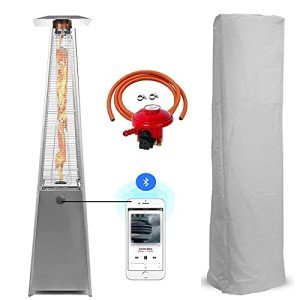For Whom Is Garden Heating Solutions And Why You Should Consider Garden Heating Solutions
Garden Heating Solutions: Enhancing Outdoor Spaces Year-Round
As seasonal changes bring varying temperatures, garden enthusiasts deal with the difficulty of maintaining their treasured outdoor spaces. Whether for cultivating plants, entertaining visitors, or simply taking pleasure in the fresh air, garden heating solutions are crucial to taking full advantage of enjoyment and functionality. This article explores various options offered for heating gardens, including conventional and modern solutions, their advantages, and practical pointers for implementation.
Understanding the Need for Garden Heating
A properly maintained garden must be a year-round sanctuary, providing reprieve in both summer and winter season. The requirement for garden heating develops from:
- Frost Protection: Certain plants, specifically tender varieties, require security from frost to endure chillier months.
- Extended Growing Seasons: Heating solutions can enable for earlier planting in spring and later harvesting in fall.
- Comfort Optimization: Outdoor gatherings and activities can take location more conveniently with regulated temperature levels.
Types of Garden Heating Solutions
Garden heating solutions can be divided into numerous categories based on their innovation and fuel source. Here's a detailed appearance at some popular options:
1. Electric Heaters
Electric heaters are a flexible option for smaller gardens and patios. They are easy to install and run, providing instantaneous heat with minimal effort.
- Types of Electric Heaters:
- Patio Heaters: Freestanding systems with a heating component that radiates heat.
- Wall-mounted Heaters: Ideal for little areas; these heaters conserve ground space while providing warmth.
- Portable Electric Fans: Great for targeted heating in specific locations.
2. Gas Heaters
Gas patio heaters are a traditional option for outdoor heating and are extensively appreciated for their efficiency and aesthetic appeal.
- Types of Gas Heaters:
- Propane Heaters: Easy to carry and set up, ideal for many outdoor settings.
- Gas Heaters: Permanent components, suitable for locations with existing gas lines.
3. Wood-burning Solutions
For a rustic touch, wood-burning solutions such as fire pits and chimineas include warmth and ambiance to gardens.
- Benefits and drawbacks of Wood-burning Heating:
- Advantages: Aesthetic appeal, social atmosphere, and reliable heat circulation.
- Disadvantages: Requires more upkeep, management of ashes, and potential fire dangers.
4. Infrared Heaters
Infrared heaters use infrared radiation to straight warm objects, making them energy-efficient and ideal for outdoor spaces.
- Benefits: Immediate heat, very little energy loss, and viability for all weather conditions.
5. Outdoor Heating Mats and Blankets
For smaller sized patio areas or particular zones in a garden, heating mats and blankets can be an ingenious service to supply an additional layer of warmth.
Considerations for Choosing a Heating Solution
When selecting the finest heating service for a garden, a number of elements need to be evaluated:
- Garden Size: Larger spaces may need multiple heating sources for effective warmth.
- Budget plan: Various options exist at various rate points. Cost-effectiveness can determine the chosen approach.
- Safety: Evaluate the security functions of the heating options, especially when using gas or wood-burning solutions.
- Aesthetic Appeal: Integration with garden design can enhance total visual satisfaction.
Table 1: Comparison of Garden Heating Solutions
Type
Installation
Fuel Source
Efficiency
Expense
Electric Heater
Easy
Electrical power
Rapid/Immediate
Moderate
Gas Heater
Moderate
Propane/Natural
High/Effective
Moderate to High
Wood-burning Option
Moderate/Hard
Wood
Reliable
Low to Moderate
Infrared Heater
Easy
Electrical energy
Immediate
Moderate to High
Heating Mats/Blankets
Easy
Electrical power
Targeted
Low to Moderate
Implementing Garden Heating Solutions
To ensure reliable heating in outdoor settings, a strategic technique is required. Here are some useful suggestions:
- Evaluate the Layout: Consider the garden design to recognize locations where heating is most needed.
- Select Multidirectional Heaters: This will help distribute heat more equally across the space.
- Enhance Insulation: Utilize windbreaks (like garden walls) or heat-retaining products around the heating setup.
- Integrate Decor: Attractive designs of heating systems can improve the garden's ambiance while offering heat.
- Regular Maintenance: Ensure that heaters (particularly gas and wood-burning) are maintained for optimum performance and safety.
Frequently Asked Questions About Garden Heating Solutions
1. How safe are electric heaters for outdoor usage?
Electric heaters designed for outdoor usage are typically safe when installed properly. Always follow producer guidelines and security guidelines to alleviate dangers.
2. Can I leave my gas heater outside throughout winter season?
While many gas heaters are developed for endurance outdoors, it's a good idea to cover them or store them inside your home to secure them from harsh weather.
3. Exist energy-efficient options for heating my garden?
Yes! Read Much more and heating mats are particularly energy-efficient as they focus heating in particular locations rather than warming the surrounding air.
4. What are the best plants to grow in a heated up garden?
Popular choices include tomatoes, herbs, peppers, and other tender plants that thrive in temperatures above 50 ° F (10 ° C).
Garden heating solutions exceptionally enhance outdoor areas, permitting for year-round enjoyment and optimized plant growth. By comprehending the numerous kinds of heating options readily available and making notified options based on personal choices and particular garden conditions, garden fans can change their outdoor areas into comfortable retreats, despite the season.
